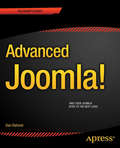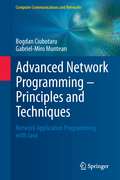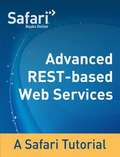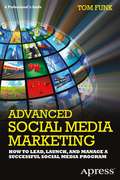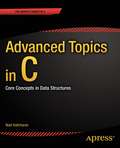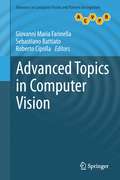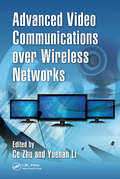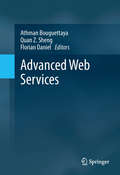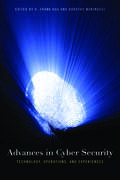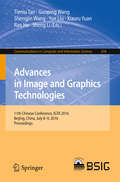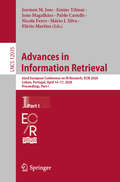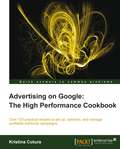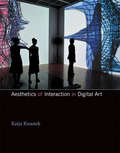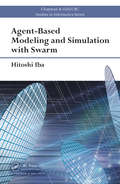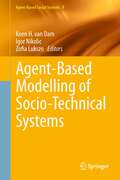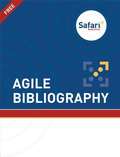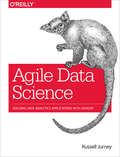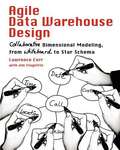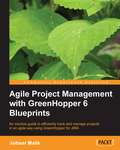- Table View
- List View
Advanced Joomla!
by Dan RahmelAdvanced Joomla! teaches you advanced techniques for customizing a Joomla! CMS, including creating templates, administration, and building extensions. It will provide the technical know-how and a bonanza of information that will allow you to take your Joomla! sites to the next level. Written by bestselling Beginning Joomla! author Dan Rahmel, Advanced Joomla! picks up right where Beginning Joomla! left off. Amongst other things, it shows you how to integrate advanced features into your Joomla! site, including social networking, blogging, and Google and Yahoo! web services; construct advanced Joomla! templates that use multiple stylesheets; use advanced administration techniques; and employ MySQL data reporting, remote deployment, and quality control using automated testing. Advanced Joomla! assists content providers and web developers in all aspects of Joomla! content creation. For graphic artists and web designers, the professional template techniques and site organization information will prove invaluable. For developers who are weary of the often Byzantine documentation and hunger for clear organized information, Advanced Joomla! holds the key to unlocking the treasures of this advanced CMS system.
Advanced Network Programming – Principles and Techniques: Network Application Programming with Java (Computer Communications and Networks)
by Bogdan Ciubotaru Gabriel-Miro MunteanAnswering the need for an accessible overview of the field, this text/reference presents a manageable introduction to both the theoretical and practical aspects of computer networks and network programming. Clearly structured and easy to follow, the book describes cutting-edge developments in network architectures, communication protocols, and programming techniques and models, supported by code examples for hands-on practice with creating network-based applications. Features: presents detailed coverage of network architectures; gently introduces the reader to the basic ideas underpinning computer networking, before gradually building up to more advanced concepts; provides numerous step-by-step descriptions of practical examples; examines a range of network programming techniques; reviews network-based data storage and multimedia transfer; includes an extensive set of practical code examples, together with detailed comments and explanations.
Advanced Photoshop CC for Design Professionals Digital Classroom
by Jennifer Smith Agi Creative TeamTake your Photoshop CC skills to the next level with this complete, advanced training packageAdobe Photoshop is the industry leading image-editing program for digital photographers, graphic designers, and web developers. The newest version includes even more great tools to manage and enhance your images. This book-and-DVD package focuses on using the more advanced Photoshop CC features such as curves, levels, blending modes, painting and drawing tools, and the latest special effects to create professional-quality designs and images for web and video. You can learn at your own pace, using the step-by-step instructions in the book and supplementary exercises on the DVD. Encourages you to develop your skills in the program's finer points with these 13 self-paced lessons developed by the AGI Creative TeamFeatures illustrated, step-by-step instructions plus video tutorials and lesson files, all created by expert instructorsCovers Adobe Bridge and Camera RAW, then focuses on advanced techniques including curves, levels, blending modes, painting and drawing tools, and the latest Photoshop CC special effectsEnables web developers and graphic designers to make full use of the advanced features of Photoshop CC (Creative Cloud)Advanced Photoshop CC Digital Classroom takes your Photoshop CC skills a step further, giving you more control over your images.Note: DVD and other supplementary materials are not included as part of the e-book file, but are available for download after purchase.
Advanced RESTful Web Services: A Safari Tutorial
by Safari Content TeamThis is the last of a three-part series looking at how to build RESTful web services. The series covers all aspects of REST services, from basic HTTP-level interactions, through to matching these operations in your existing code and applications, network security, and adherence for REST standards. With advanced REST deployments, the key considerations are the methods required to build, deploy, and place your REST solution into production. Key to this should be understanding how best to implement your web services and RESTful architecture to take advantage of the SOA environment and your existing enterprise infrastructure. Deployment requires testing and installation within the distributed environment of your typical SOA deployment. Follow along in this tutorial to learn about all of these advanced RESTful skills in Safari Books Online.
Advanced Social Media Marketing: How to Lead, Launch, and Manage a Successful Social Media Program
by Tom FunkThey are laborers, soldiers, refugees, and orphans. In areas of the world torn by poverty, disease, and war, millions of children are invisible victims, deprived of home, family, and basic human rights. Their chances for a stable adult life are extremely slim. The powerful interdisciplinary volume Vulnerable Children brings a global child-rights perspective to the lives of indigenous, refugee, and minority children in and from?crisis-prone regions. Focusing on self-determination, education, security, health, and related issues, an international panel of scholars examines the structural and political sources of children''s vulnerabilities and their effects on development. The book analyzes intervention programs currently in place and identifies challenges that must be met at both the community and larger policy levels. These chapters also go a long way to explain the often-blurred line between vulnerability and resilience. Included in the coverage: Dilemmas of rights-based approaches to child well-being in an African cultural context. Poverty and minority childrenOCOs education in the U. S. : case study of a Sudanese refugee family. The heterogeneity of young childrenOCOs experiences in Kenya and Brazil. A world tour of interventions for children of a parent with a psychiatric illness. An exploration of fosterage of Owambo orphans in Namibia. UNICEF in Colombia: defending and nurturing childhood in media, public, and policy discourses. Vulnerable Children is a must-have volume for researchers, graduate students, and clinicians/professionals/practitioners across a range of fields, including child and school psychology, social work, maternal and child health, developmental psychology, anthropology, sociology, social policy, and public health"
Advanced Topics in C: Core Concepts in Data Structures
by Noel KalicharanC is the most widely used programming language of all time. It has been used to create almost every category of softwareimaginable and the list keeps growing every day. Cutting-edge applications, such as Arduino, embeddable and wearable computing are ready-made for C. AdvancedTopics In C teaches concepts that any budding programmer should know. You'll delve into topics such as sorting, searching, merging, recursion, random numbers and simulation, among others. You will increase the range of problems you can solve when you learn how to manipulate versatile and popular data structures such as binary trees and hash tables. This book assumes you have a working knowledge of basic programming concepts such as variables, constants, assignment, selection (if. . else) and looping (while, for). It also assumes you are comfortable with writing functions and working with arrays. If you study this book carefully and do the exercises conscientiously, you would become a better and more agile programmer, more prepared to code today's applications (such as the Internet of Things) in C. "
Advanced Topics in Computer Vision (Advances in Computer Vision and Pattern Recognition)
by Sebastiano Battiato Giovanni Maria Farinella Roberto CipollaThis book presents a broad selection of cutting-edge research, covering both theoretical and practical aspects of reconstruction, registration, and recognition. The text provides an overview of challenging areas and descriptions of novel algorithms. Features: investigates visual features, trajectory features, and stereo matching; reviews the main challenges of semi-supervised object recognition, and a novel method for human action categorization; presents a framework for the visual localization of MAVs, and for the use of moment constraints in convex shape optimization; examines solutions to the co-recognition problem, and distance-based classifiers for large-scale image classification; describes how the four-color theorem can be used for solving MRF problems; introduces a Bayesian generative model for understanding indoor environments, and a boosting approach for generalizing the k-NN rule; discusses the issue of scene-specific object detection, and an approach for making temporal super resolution video.
Advanced Video Communications over Wireless Networks
by Ce Zhu Yuenan LiWireless video communications encompass a broad range of issues and opportunities that serve as the catalyst for technical innovations. To disseminate the most recent advances in this challenging yet exciting field, Advanced Video Communications over Wireless Networks provides an in-depth look at the fundamentals, recent technical achievements, challenges, and emerging trends in mobile and wireless video communications. The editors have carefully selected a panel of researchers with expertise in diverse aspects of wireless video communication to cover a wide spectrum of topics, including the underlying theoretical fundamentals associated with wireless video communications, the transmission schemes tailored to mobile and wireless networks, quality metrics, the architectures of practical systems, as well as some novel directions. They address future directions, including Quality-of-Experience in wireless video communications, video communications over future networks, and 3D video communications. The book presents a collection of tutorials, surveys, and original contributions, providing an up-to-date, accessible reference for further development of research and applications in mobile and wireless video communication systems. The range of coverage and depth of expertise make this book the go-to resource for facing current and future challenges in this field.
Advanced Web Services (Advances In Database Systems Ser.)
by Quan Z. Sheng Athman Bouguettaya Florian DanielWeb services and Service-Oriented Computing (SOC) have become thriving areas of academic research, joint university/industry research projects, and novel IT products on the market. SOC is the computing paradigm that uses Web services as building blocks for the engineering of composite, distributed applications out of the reusable application logic encapsulated by Web services. Web services could be considered the best-known and most standardized technology in use today for distributed computing over the Internet. This book is the second installment of a two-book collection covering the state-of-the-art of both theoretical and practical aspects of Web services and SOC research and deployments. Advanced Web Services specifically focuses on advanced topics of Web services and SOC and covers topics including Web services transactions, security and trust, Web service management, real-world case studies, and novel perspectives and future directions. The editors present foundational topics in the first book of the collection, Web Services Foundations (Springer, 2013). Together, both books comprise approximately 1400 pages and are the result of an enormous community effort that involved more than 100 authors, comprising the world's leading experts in this field.
Advances in Cyber Security: Technology, Operations, and Experiences
by D. Frank Hsu Dorothy MarinucciAs you read this, your computer is in jeopardy of being hacked and your identity being stolen. Read this book to protect yourselves from this threat.The world’s foremost cyber security experts, from Ruby Lee, Ph.D., the Forrest G. Hamrick professor of engineering and Director of the Princeton Architecture Laboratory for Multimedia and Security (PALMS) at Princeton University; to Nick Mankovich, Chief Information Security Officer of Royal Philips Electronics; toFBI Director Robert S. Mueller III; to Special Assistant to the President Howard A. Schmidt, share critical practical knowledge on how the cyberspace ecosystem is structured, how it functions, and what we can do to protect it and ourselves from attack and exploitation.The proliferation of social networking and advancement of information technology provide endless benefits in our living and working environments. However, these benefits also bring horrors in various forms of cyber threats and exploitations. Advances in Cyber Security collects the wisdom of cyber security professionals and practitioners from government, academia, and industry across national and international boundaries to provide ways and means to secure and sustain the cyberspace ecosystem. Readers are given a first-hand look at critical intelligence on cybercrime and security—including details of real-life operations. The vast, useful knowledge and experience shared in this essential new volume enables cyber citizens and cyber professionals alike to conceive novel ideas and construct feasible and practical solutions for defending against all kinds of adversaries and attacks.Among the many important topics covered in this collection are building a secure cyberspace ecosystem; public–private partnership to secure cyberspace; operation and law enforcement to protect our cyber citizens and to safeguard our cyber infrastructure; and strategy and policy issues to secure and sustain our cyberecosystem.
Advances in Image and Graphics Technologies: 11th Chinese Conference, IGTA 2016, Beijing, China, July 8-9, 2016, Proceedings (Communications in Computer and Information Science #634)
by Sheng Li Ran He Tieniu Tan Guoping Wang Shengjin Wang Yue Liu Xiaoru YuanThis book constitutes the refereed proceedings of the Chinese Conference on Image and Graphics Technologies and Applications, IGTA 2013, held in Beijing, China, in April 2013. The 40 papers and posters presented were carefully reviewed and selected from 89 submissions. The papers address issues such as the generation of new ideas, new approaches, new techniques, new applications and new evaluation in the field of image processing and graphics.
Advances in Information Retrieval: 35th European Conference On Ir Research, Ecir 2013, Moscow, Russia, March 24-27, 2013, Proceedings (Lecture Notes In Computer Science Series #7814)
by Nicola Ferro Joemon M. Jose Emine Yilmaz João Magalhães Pablo Castells Mário J. Silva Flávio MartinsThis two-volume set LNCS 12035 and 12036 constitutes the refereed proceedings of the 42nd European Conference on IR Research, ECIR 2020, held in Lisbon, Portugal, in April 2020. The 55 full papers presented together with 8 reproducibility papers, 46 short papers, 10 demonstration papers, 12 invited CLEF papers, 7 doctoral consortium papers, 4 workshop papers, and 3 tutorials were carefully reviewed and selected from 457 submissions. They were organized in topical sections named: Part I: deep learning I; entities; evaluation; recommendation; information extraction; deep learning II; retrieval; multimedia; deep learning III; queries; IR – general; question answering, prediction, and bias; and deep learning IV. Part II: reproducibility papers; short papers; demonstration papers; CLEF organizers lab track; doctoral consortium papers; workshops; and tutorials.
Advances in Statistical Bioinformatics: Models and Integrative Inference for High-Throughput Data
by Kim-Anh Do Zhaohui Steve Qin Marina VannucciProviding genome-informed personalized treatment is a goal of modern medicine. Identifying new translational targets in nucleic acid characterizations is an important step toward that goal. The information tsunami produced by such genome-scale investigations is stimulating parallel developments in statistical methodology and inference, analytical frameworks, and computational tools. Within the context of genomic medicine and with a strong focus on cancer research, this book describes the integration of high-throughput bioinformatics data from multiple platforms to inform our understanding of the functional consequences of genomic alterations. This includes rigorous and scalable methods for simultaneously handling diverse data types such as gene expression array, miRNA, copy number, methylation, and next-generation sequencing data. This material is written for statisticians who are interested in modeling and analyzing high-throughput data. Chapters by experts in the field offer a thorough introduction to the biological and technical principles behind multiplatform high-throughput experimentation.
Advances in Type-2 Fuzzy Sets and Systems: Theory and Applications (Studies in Fuzziness and Soft Computing #301)
by Jerry Mendel Alireza Sadeghian Hooman TahayoriThis book explores recent developments in the theoretical foundations and novel applications of general and interval type-2 fuzzy sets and systems, including: algebraic properties of type-2 fuzzy sets, geometric-based definition of type-2 fuzzy set operators, generalizations of the continuous KM algorithm, adaptiveness and novelty of interval type-2 fuzzy logic controllers, relations between conceptual spaces and type-2 fuzzy sets, type-2 fuzzy logic systems versus perceptual computers; modeling human perception of real world concepts with type-2 fuzzy sets, different methods for generating membership functions of interval and general type-2 fuzzy sets, and applications of interval type-2 fuzzy sets to control, machine tooling, image processing and diet. The applications demonstrate the appropriateness of using type-2 fuzzy sets and systems in real world problems that are characterized by different degrees of uncertainty.
Advertising on Google: The High Performance Cookbook
by Kristina CuturaThis book contains practical recipes on everything from creating an Adwords account, reporting, analyzing, bidding effectively to remarketing. The book is a guide to getting hands-on experience in Adwords strategies. It is extensively focussed on helping you build an Adwords account, which appeals to the visitors and attracts more clicks!This book is great for the users, who are ready to start using Adwords, as well as for experienced advertisers, who are looking to take their accounts to the next level. Just create an Adwords account and run ad campaigns to take advantage of the hands-on recipes.
Aesthetics of Interaction in Digital Art (The\mit Press Ser.)
by Katja KwastekAn art-historical perspective on interactive media art that provides theoretical and methodological tools for understanding and analyzing digital art.Since the 1960s, artworks that involve the participation of the spectator have received extensive scholarly attention. Yet interactive artworks using digital media still present a challenge for academic art history. In this book, Katja Kwastek argues that the particular aesthetic experience enabled by these new media works can open up new perspectives for our understanding of art and media alike. Kwastek, herself an art historian, offers a set of theoretical and methodological tools that are suitable for understanding and analyzing not only new media art but also other contemporary art forms. Addressing both the theoretician and the practitioner, Kwastek provides an introduction to the history and the terminology of interactive art, a theory of the aesthetics of interaction, and exemplary case studies of interactive media art.Kwastek lays the historical and theoretical groundwork and then develops an aesthetics of interaction, discussing such aspects as real space and data space, temporal structures, instrumental and phenomenal perspectives, and the relationship between materiality and interpretability. Finally, she applies her theory to specific works of interactive media art, including narratives in virtual and real space, interactive installations, and performance—with case studies of works by Olia Lialina, Susanne Berkenheger, Stefan Schemat, Teri Rueb, Lynn Hershman, Agnes Hegedüs, Tmema, David Rokeby, Sonia Cillari, and Blast Theory.
After Effects CC Digital Classroom
by Agi Creative Team Jerron SmithEdit and apply effects for stellar visual and special effectsThis important resource is like having a personal instructor guiding you through each lesson, while you work at your own pace. Each self-paced lesson lets you discover essential skills and explore the new features and capabilities of Adobe After Effects CC (Creative Cloud). Every lesson is presented in full color with step-by-step instructions. Video tutorials and lesson files on a companion DVD were developed by the same team of professional instructors and After Effects experts who have created many of the official training titles for Adobe Systems.Combines a full-color, step-by-step instructional book along with lesson files and video training from expert instructorsWritten for After Effects CC, a leading motion graphics and visual effects program that allows users to create and deliver compelling motion graphics and visual effectsDemonstrates how to quickly get up to speed using After Effects to create and animate text, images, and video for the web, TV, and digital displaysAfter Effects CC Digital Classroom takes you from the basics through intermediate-level topics, teaching you this complex software in a clear, approachable manner. DVD and other supplementary materials are not included as part of the e-book file, but are available for download after purchase.
Agent-Based Approaches in Economic and Social Complex Systems VII: Post-Proceedings of The AESCS International Workshop 2012 (Agent-Based Social Systems #10)
by Takao Terano Shingo Takahashi Tadahiko MurataAgent-based modeling/simulation is an emergent approach to the analysis of social and economic systems. It provides a bottom-up experimental method to be applied to social sciences such as economics, management, sociology, and politics as well as some engineering fields dealing with social activities. This book includes selected papers presented at the Seventh International Workshop on Agent-Based Approaches in Economic and Social Complex Systems held in Osaka, Japan, in 2012. At the workshop, 24 reviewed full papers were presented, and of those, 17 were selected to be included in this volume. The papers are divided into two groups as "Fundamentals of Agent-Based Modeling" and "Applications of Agent-Based Modeling".
Agent-Based Modeling and Simulation with Swarm (Chapman & Hall/CRC Studies in Informatics Series)
by Hitoshi IbaSwarm-based multi-agent simulation leads to better modeling of tasks in biology, engineering, economics, art, and many other areas. It also facilitates an understanding of complicated phenomena that cannot be solved analytically. Agent-Based Modeling and Simulation with Swarm provides the methodology for a multi-agent-based modeling approach that i
Agent-Based Modelling of Socio-Technical Systems (Agent-Based Social Systems #9)
by Zofia Lukszo Koen H. Dam Igor NikolicDecision makers in large scale interconnected network systems require simulation models for decision support. The behaviour of these systems is determined by many actors, situated in a dynamic, multi-actor, multi-objective and multi-level environment. How can such systems be modelled and how can the socio-technical complexity be captured? Agent-based modelling is a proven approach to handle this challenge. This book provides a practical introduction to agent-based modelling of socio-technical systems, based on a methodology that has been developed at TU Delft and which has been deployed in a large number of case studies. The book consists of two parts: the first presents the background, theory and methodology as well as practical guidelines and procedures for building models. In the second part this theory is applied to a number of case studies, where for each model the development steps are presented extensively, preparing the reader for creating own models.
Agentenbasierte Schwarmintelligenz
by Tjorben BogonDas autonome Verteilen von inhärenten Systemen ist eine komplexe, nicht immer funktionierende Aufgabe. Naturinspirierte Optimierungsmethoden wie die Partikel Schwarm Optimierung (PSO) sind nur bedingt verteilt parallel berechenbar. Tjorben Bogon entwickelt eine signifikante Verbesserung der PSO, welche auf einer Analyse der autonomen Anpassungs- und Verbesserungsmöglichkeiten von Metaheuristiken basiert. Der Fokus liegt dabei auf der autonomen dynamischen Steuerung und Integration von Zusatzwissen in den aktuellen Optimierungsverlauf. Der Autor untersucht, wie zum einen neues Wissen aus dem Optimierungsverlauf generiert werden kann und zum anderen, wie dieses Wissen verbreitet und in andere Optimierungen eingebunden werden kann. Er analysiert diese Aufgaben unter der Prämisse einer Anbindung eines Agentensystems und zeigt, wie die Optimierung effizienter ausgeführt und wie sie parallel kooperativ durchgeführt werden kann.
Agile Bibliography
by Safari Content TeamAgile is an approach to software development that improves quality and customer satisfaction. It also reduces risk by focusing on effective collaboration between software developers and business experts, and the frequent delivery of deployable releases that contain new and valuable business features. Agile, by its very nature, is iterative and uses fixed timebox sprints created by self-organizing cross-functional teams. Face-to-face interactions are preferred over written documentation, since those instruments typically become obsolete long before the project comes to fruition. Popular agile methodologies include XP, Scrum and the earlier Dynamic Systems Development Method (DSDM). The success of agile has been remarkable and recent advances have come in the form of approaches that support scaling agility, and working in organizations that have audit and compliance requirements. Also important is meeting the needs of organizations that have resources spread across multiple locations that may be too far to allow for face-to-face interactions. Agile is evolving and gaining in popularity with its focus on managing risk, improving quality and productivity, while maintaining both customer and a results-oriented focus that leads to successful systems and successful businesses! Follow along in this Safari Books Online bibliography to learn more about all of the Agile aspects that have been covered here.
Agile Data Science
by Russell JurneyMining big data requires a deep investment in people and time. How can you be sure you're building the right models? With this hands-on book, you'll learn a flexible toolset and methodology for building effective analytics applications with Hadoop. Using lightweight tools such as Python, Apache Pig, and the D3.js library, your team will create an agile environment for exploring data, starting with an example application to mine your own email inboxes. You'll learn an iterative approach that enables you to quickly change the kind of analysis you're doing, depending on what the data is telling you. All example code in this book is available as working Heroku apps. Create analytics applications by using the agile big data development methodology Build value from your data in a series of agile sprints, using the data-value stack Gain insight by using several data structures to extract multiple features from a single dataset Visualize data with charts, and expose different aspects through interactive reports Use historical data to predict the future, and translate predictions into action Get feedback from users after each sprint to keep your project on track
Agile Data Warehouse Design: Collaborative Dimensional Modeling, From Whiteboard To Star Schema
by Lawrence Corr Jim StagnittoAgile Data Warehouse Design is a step-by-step guide for capturing data warehousing/business intelligence (DW/BI) requirements and turning them into high performance dimensional models in the most direct way: by modelstorming (data modeling ] brainstorming) with BI stakeholders. This book describes BEAM, an agile approach to dimensional modeling, for improving communication between data warehouse designers, BI stakeholders and the whole DW/BI development team. BEAM provides tools and techniques that will encourage DW/BI designers and developers to move away from their keyboards and entity relationship based tools and model interactively with their colleagues. The result is everyone thinks dimensionally from the outset Developers understand how to efficiently implement dimensional modeling solutions. Business stakeholders feel ownership of the data warehouse they have created, and can already imagine how they will use it to answer their business questions. Within this book, you will learn: Agile dimensional modeling using Business Event Analysis & Modeling (BEAM ) Modelstorming: data modeling that is quicker, more inclusive, more productive, and frankly more fun Telling dimensional data stories using the 7Ws (who, what, when, where, how many, why and how) Modeling by example not abstraction; using data story themes, not crow's feet, to describe detail Storyboarding the data warehouse to discover conformed dimensions and plan iterative development Visual modeling: sketching timelines, charts and grids to model complex process measurement - simply Agile design documentation: enhancing star schemas with BEAM dimensional shorthand notation Solving difficult DW/BI performance and usability problems with proven dimensional design patterns LawrenceCorr is a data warehouse designer and educator. As Principal of DecisionOne Consulting, he helps clients to review and simplify their data warehouse designs, and advises vendors on visual data modeling techniques. He regularly teaches agile dimensional modeling courses worldwide and has taught dimensional DW/BI skills to thousands of students. Jim Stagnitto is a data warehouse and master data management architect specializing in the healthcare, financial services, and information service industries. He is the founder of the data warehousing and data mining consulting firm Llumino.
Agile Project Management with GreenHopper 6 Blueprints
by Jaibeer MalikA step-by-step tutorial-based approach.This book is of great help for agile teams who are already using or planning to use the GreenHopper tooling system to execute agile projects. It suits all roles in an agile project including system administrators, stakeholders, product owners, scrum masters, and team members. Fundamental knowledge of JIRA is essential.
